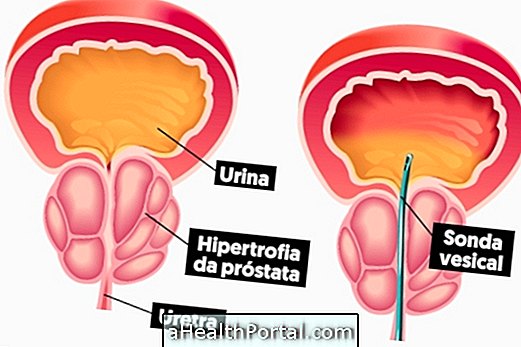Bladder catheterization is a technique that involves the introduction of a catheter, also known as a bladder catheter, through the urethra to the bladder in order to allow urine output in people who can not control it, due to obstructions such as hypertrophy of the bladder. prostate, urethral dilatation or even in cases where you want to perform tests in sterile urine or prepare the person for surgery, for example.
This technique should be performed only if necessary and ideally should be done by a health professional, since the risk of developing infections, injuries and bleeding is very great. However, there are also some cases where the introduction of the probe may be indicated to do at home, but in those cases the correct technique needs to be taught by a nurse.

What is it for
Due to the risks of the technique, the catheterization should only be used if it is even necessary, in the following cases:
- Relief of acute or chronic urinary retention;
- Control of the production of urine by the kidney;
- Post-renal renal insufficiency due to infra-vesical obstruction;
- Loss of blood through the urine;
- Collection of sterile urine for examination;
- Measurement of residual volume;
- Control of urinary incontinence;
- Ureteral dilation;
- Evaluation of the lower urinary tract dynamics;
- Bladder emptying before, during and after surgeries and exams;
In addition, bladder catheterization can also be used to perform the administration of medications directly into the bladder, in cases of severe infections, for example.
What material do you need?
Generally, the material used to perform this technique consists of a sterile bladder catheterization package with:
- Pean claws;
- Gauze package;
- Small round Cuba;
- Festooned slotted field;
- Bladder catheter;
- Collecting bag;
- Liquid aseptic solution, such as iodopovidone;
- 20 ml syringe;
- Anesthetic gel, such as lidocaine;
- Ampoule of distilled water;
- Gloves.
The bladder catheter should have the smallest possible caliber capable of providing adequate urine drainage so as to minimize lesions in the urethra. The collection bag should be sufficiently large to allow mobility and not cause strain on the catheter and consequent urethral injury.

What is the procedure
This procedure should always be performed by a health professional and before doing so, the person should be explained how the technique will be done, which usually consists of the following:
- Gather all the necessary material;
- Put on gloves and wash the person's inner part;
- Wash hands;
- Open the catheter package next to the person, sterile;
- Open the indicated probe package and place it next to the tank, without contamination;
- Place the lubricant on one of the gauzes of the package;
- Ask for the person to lie on their belly, in the gynecological position for the female and the legs together, for the male sex;
- Put on the sterile catheter package gloves;
- Lubricate probe tip;
- For females, do the antisepsis with the forceps mounted, separating the small lips with the thumb and forefinger, passing a wet antiseptic gauze between the large and small lips and the urinary meatus;
- For the male, do antisepsis on the glans with the clamp mounted with gauze moistened in the antiseptic, pushing away with the thumb and forefinger of the left hand the foreskin covering the glans and urinary meatus;
- Pick up the probe with the hand that has not come in contact with the small area and insert into the urethra, and leave the other end inside the tub, checking the exit of the urine;
- Inflate the probe flask with 10 to 20 mL of distilled water.
At the end of the procedure, the catheter should be attached, which in men is placed in the supra pubic region and in women is applied to the inner side of the thigh.
Types of bladder catheterization
There are two types of bladder catheterization:
1. Delayed vesical catheterization
Delayed bladder catheterization is used when the catheter remains longer for continuous drainage and a Foley or Owen catheter is used.
In this technique, the catheter remains for continuous drainage, allowing for gradual decompression of the bladder and is indicated to promote bladder emptying, to monitor urine output, to perform surgical preparation, to perform bladder irrigation or to decrease urine contact with lesions close to the genital area.
2. Bladder catheterization of relief or intermittent
In bladder catheterization, the catheter does not stay in the person for a long time, and the Nelaton catheter is the most commonly used catheter.
Generally, this technique is used to drain the urine present in the bladder before medical procedures or for immediate relief in people with paralysis and urinary retention, for example. It can also be used in people with neurogenic bladder, to obtain a sterile urine sample or to examine residual urine after spontaneous emptying of the bladder.
What are the risks
Bladder catheterization should only be performed if it is necessary because it presents risks such as urinary tract infection, which is more frequent in the female sex, the elderly and people with renal insufficiency, which may occur due to an inadequate preparation of the peri-urethral area before of catheter insertion, inadequate technique in catheter installation, trauma to the urethra by catheter pressure, contamination in the catheter tube connection region, or contamination of the collecting pouches with reflux to the bladder.
Other risks of the technique are bleeding, which can be caused by the use of a catheter of inadequate caliber to the size of the urethra, incorrect passage of the catheter or existence of previous diseases, formation of calculi in the bladder due to a long permanence of the catheter and lesions in the apparatus due to the application of excessive force during the passage or use of a catheter of a caliber greater than the recommended one.
Learn how to take care of the bladder catheter in order to minimize the risks of infection.


















